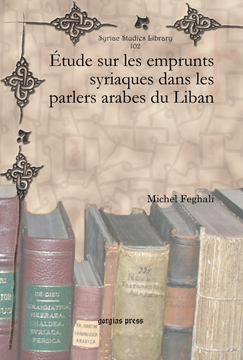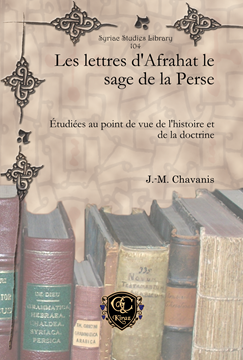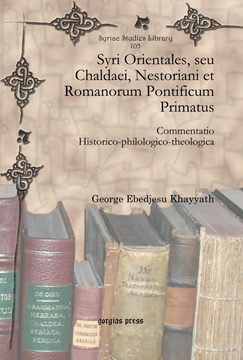The Book of the Priesthood
The First Homily on the Priesthood attributed to John Maron
Edited and Translated by Joseph Hubeika
Series: Syriac Studies Library 100
ISBN: 978-1-61719-201-2
Joseph Hubeika (1878-1944) here presents the Syriac text and Arabic translation of a long work on the priesthood attributed to Yuhanon Maron, but in fact from the hand of John of Dara.
$212.00 (USD)
De S. Isaaci Ninivitae Vita, Scriptis et Doctrina
Accedunt Isaaci Tres Integri Sermones
Series: Syriac Studies Library 101
ISBN: 978-1-61719-202-9
In this volume, Chabot is concerned with the life and work of the widely influential Church of the East author Isaac of Nineveh (late 7th cent.). Three sermons, in Syriac and Latin, conclude the work.
$162.00 (USD)
Étude sur les emprunts syriaques dans les parlers arabes du Liban
Series: Syriac Studies Library 102
ISBN: 978-1-61719-203-6
The present work, Michel Feghali’s doctoral dissertation, is the first large scale investigation of the survival of Syriac linguistic features in Arabic dialects; he examines in particular, the Lebanese dialects.
$117.00 (USD)
L’école d’Édesse
By E.R. Hayes
Series: Syriac Studies Library 103
ISBN: 978-1-61719-204-3
In this work, the author’s doctoral thesis, Hayes looks at the “school” very broadly in general terms of the Christian intellectual and theological milieu of the city.
$194.00 (USD)
Les lettres d’Afrahat le sage de la Perse
Étudiées au point de vue de l’histoire et de la doctrine
Series: Syriac Studies Library 104
ISBN: 978-1-61719-205-0
This volume, the author’s doctoral thesis, contains a detailed but concise study of Aphrahat’s Demonstrations. The main part of the book is divided into two parts: the Church in Persia, and doctrine in the Demonstrations.
$158.00 (USD)
Syri Orientales, seu Chaldaei, Nestoriani et Romanorum Pontificum Primatus
Commentatio Historico-philologico-theologica
Series: Syriac Studies Library 105
ISBN: 978-1-61719-206-7
Khayyath, Chaldean archbishop of Amid, here explores the literary testimonies of writers in Syriac and Arabic from the Church of the East on the question of the primacy of the Roman pontiff.
$174.00 (USD)
The Life and Works of Severus of Antioch in the Coptic and Copto-Arabic Tradition
Texts and Commentaries
Series: Gorgias Eastern Christian Studies 28
ISBN: 978-1-61719-738-3
Severus of Antioch is by far the most prolific and well known theologian of the non-Chalcedonian churches. Although his life and writings came to our knowledge in Syriac, gaining him the title “Crown of the Syriac Literature,” many texts relating to his life and works survived in the Coptic and Copto-Arabic tradition, as well as a number of other texts that were traditionally attributed to him. This book provides an analysis of these texts as well as a discussion of the veneration of Severus of Antioch in the Coptic Church.
$223.00 (USD)
I Fasti della Chiesa Patriarcale Antiochena
Series: Analecta Gorgiana 632
ISBN: 978-1-61719-581-5
In this work, Rahmani gives a survey of the Church at Antioch and its relationship to other churches, especially the Roman, and publishes (with Latin translation) a number of unedited texts (all Syriac, except one in Arabic).
$47.00 (USD)
Neusyrisches Lesebuch
Texte im Dialecte von Urmia gesammelt, übersetzt und erklärt
Edited and Translated by Adalbert Merx
Series: Analecta Gorgiana 633
ISBN: 978-1-61719-582-2
This collection of texts in the Neo-Aramaic dialect of Urmia, with parallel German translation and vocabulary notes, includes stories, material on baptism, a wedding, Araq and wine, history of the region, and several letters or parts thereof.
$47.00 (USD)
Das Nestorianische Denkmal in Singan Fu
By J.E. Heller
Series: Analecta Gorgiana 634
ISBN: 978-1-61719-583-9
This work is a survey of the text and research on the famous so-called Nestorian monument (or stele) from China, including a review of previous scholarship, as well a fresh translation and commentary.
$45.00 (USD)









